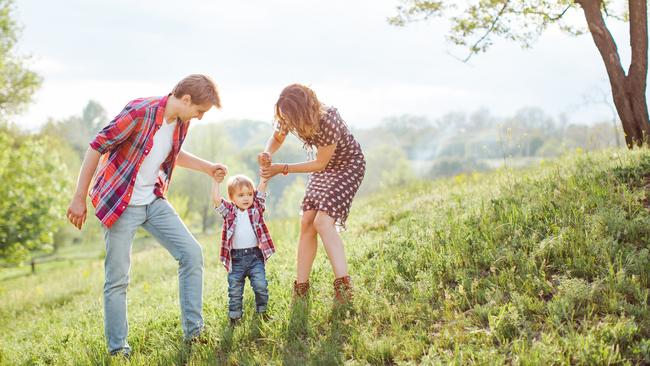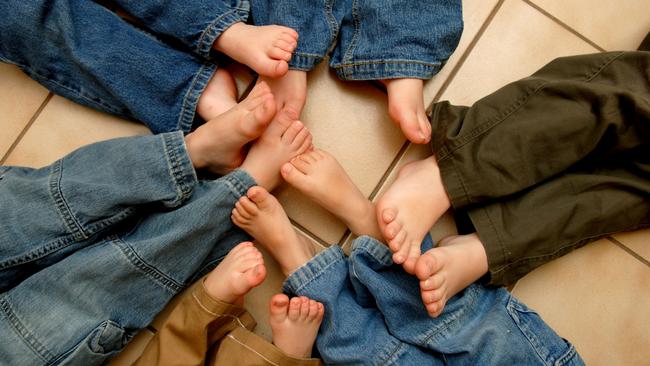
They may be morphing and contorting and fracturing and rebirthing but they remain — stubbornly, stoically, surprisingly — the building blocks of the Australian nation and people. I am talking the F-word here. I am talking families. Families that are big and small and medium and traditional and blended — in fact, there are families that are cobbled together in ways few of us could imagine.
There’s mum, dad and the kids; there’s mum and the kids; there’s dad and the kids; there’s grandma and her single-mother daughter and her kids and cousins and even the odd uncle. All tossed in together to form deliciously different ways of raising children. Here is the kind of familial mishmash that shapes our lives and relationships.
And at the core of the way the Australian people live there is the loving, and for many just as maddening, family.
For all their faults and their bickering and their oddball personalities, families are the tribes from whence we all spring.
Almost half the nation belongs to a family with dependent children. A quarter of us live as couples and almost a third live as singles. And even though singles and couples are certainly surging, they are rising off a low base. The family will continue to dominate the Australian social landscape for another generation.
But here’s the thing. Families come in all shapes and sizes and they are contorting in every direction. Across the decade to 2016 the population grew by 18 per cent, but the number of people living in families with eight-plus people increased by 64 per cent to 266,000.
These super-sized families can comprise mum, dad and six or more kids, but they can also comprise a single mum with five kids and a cousin; or, indeed, any number of other combinations. Seven-person families jumped 46 per cent and six-person families jumped 19 per cent during the same decade. Big families are on the move.

But the real action is in the mid-tier market. Of the 11 million Australians living in a family with some sort of dependent child, four million are in families of four, mostly in the traditional configuration of mum, dad and two kids.
If you belong to one of these families, I must inform you that your family unit is dreadfully common and slow moving: the overall numbers for this particular family type are up just 15 per cent over the past decade, although this does translate into 538,000 net extra families, most of which would want to live in a separate house on a separate block of land.
Developers, take note: mum and dad and two kids is a life form that is expanding at an average rate of 54,000 units a year. They require no fewer than three bedrooms, plus room to move. Most will want to live in a McMansion in suburbia but you may be able to entice some of the former hipster variety of parents to move into a Manhattanesque apartment. Take them to a cafe and offer them smashed … never mind.
Five-person and three-person families each comprise just more than two million households. The smaller of these two family models is growing faster (up 15 per cent since 2006) than the bigger model (up 9 per cent). Five and even six-person families are less popular with this generation of Australians than are very big (seven-plus) and very small (three-person) families. There are, in fact, 341,000 two-person families comprised of a single parent (or guardian) and one dependent child.
Maybe there’s a critical mass of kids (around the three to four mark) and beyond where the extra child doesn’t translate into a proportionate reduction in lifestyle. Maybe after four kids parents think, “in for a penny, in for a pound — maybe we should go for a fifth”, and the whole big-family thing kinda takes off from there.
I am particularly intrigued by a 19 per cent increase across 10 years in the number of three-person families with dependent kids under the age of 15. This can include a single mum and two kids but it is likelier to comprise mum, dad and a single child. There are 1.3 million such families in Australia, up 205,000 since 2006. If both parents work then what we are witnessing is the transformation of the double income, no kids (DINK) life form into the double income, single kid (or DISK) life form. And because their kids are young (under 15), the DISK parents are probably millennials in their 30s.

Could it be that the 20-something hipster movement of the past decade is transforming into a 30-something DISKer movement this decade as millennials hook up and have a single child? Perhaps the next iteration of Australian parenthood involves reimagining how and where kids may be raised. Yes, the traditional McMansion model of the family remains popular but there are newer, sleeker, inner-city models contemplated in the Family 2.0.
One version of this DISK family opts for life on the city edge while another remains firmly entrenched in the inner city. The common denominator is that both parents work. Whereas 6.9 per cent of the population lives in three-person families, the proportion in Melbourne’s Point Cook is 16 per cent while in Sydney’s Hornsby it is 14 per cent.
But there are evolving DISK enclaves located closer to the city centre in places such as Melbourne’s Albert Park and Sydney’s Paddington, where this life form comprises more than 8 per cent of the population. Brisbane’s hipster-to-DISKer movement is clearly slower off the mark in places such as West End, where three-person families make up just 7 per cent of the population.
At the other end of the spectrum are our supersized families. Across the nation, members of families of eight-plus make up just 1.1 per cent of the population. However, in east Arnhem 48 per cent of the population is part of big families that include dependent children. In Yarrabah near Cairns, 36 per cent of the community consists of big families.
Within capital cities, families of eight-plus members are most likely to be found in places such as Melbourne’s Tarneit, where members of such families make up 4 per cent of the population. Other big-family hot spots are South Granville in Sydney (6 per cent) and Redbank Plains in Brisbane (5 per cent), both favoured by Indian and other migrant communities.
In the four-person family heartland the traditional model of mum, dad and two kids is shifting. About two-thirds of the growth during the past decade has involved families with children under the age of 15. The other third involved families with dependent students aged 16 and older. The centre of gravity of the traditional family base is growing older.
Kids stay at home longer and they require study space; houses must be bigger; a second bathroom is more or less mandatory; young adult children have their partners “stay over”.
Then there’s the delicate issue of managing visiting partners in households that still accommodate younger siblings. It’s all getting very complicated. New rules and new protocols must evolve to manage the comings and goings.
While the family remains the biggest single social structure in Australia, other living arrangements are gathering momentum.
Singles and couple households combined account for 55 per cent of households, which means that most Australian households are childless.
Kids have captured less than half the housing stock, which has enabled housing fashion and design to evolve in a particular direction, namely kidless minimalism. These visions of interior loveliness have colour schemes of daring white-on-white. Here are visions of cleanliness and perfectness that only childless couples — including grandchildless empty-nesters perhaps — will know.

The only way Australia’s big and aspirational families with kids can compete in this brave new world of minimalism is to demand something like a butler’s pantry to hide the eternal shame of a kitchen’s real cooking stains. Shut the door on the butler’s pantry and the minimalist kitchen remains unsullied and untouched by the hands of children.
This is not so much the rise and fall of the family as it is a contortion of the concept of the family. The traditional family model that so shaped Australian suburbia and society is on the move and so, too, is the way we live.
The three-bedroom brick veneer is being reimagined as a four-bedroom, two-bathroom McMansion. And the family’s suburbia is giving way to the apartmentia of singles and couples.
Families with dependent kids are still a vital part of our nation but their influence on the way we live and even in our sense of design is receding. The Family 2.0 still delivers and nurtures kids but the traditional concept of family life is conceding social power and even design influence to the rising clout of singles and couples.
The question is whether at some point kids will rise again to reclaim their place amid the majority of Australia’s housing stock.
Should that turn out to be the case, perhaps our design aesthetic will then shift back to the messy, lived-in look.
Some of us can only hope.
Bernard Salt is a special adviser to KPMG Australia; research by Simon Kuestenmacher.
bsalt@kpmg.com.au.




To join the conversation, please log in. Don't have an account? Register
Join the conversation, you are commenting as Logout